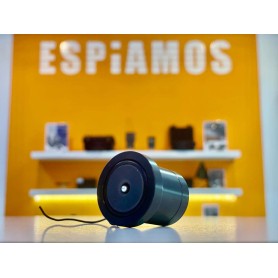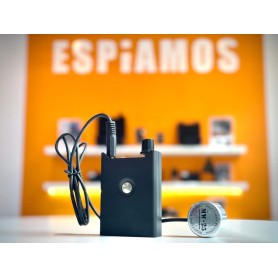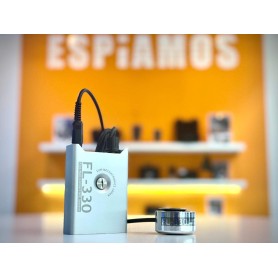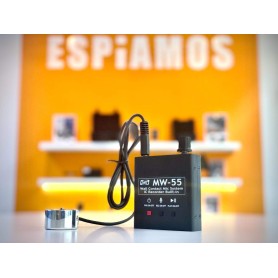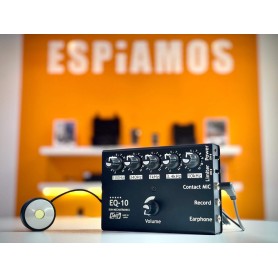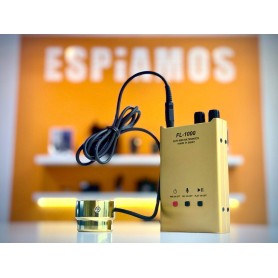
Wall Microphone: Hear Through Surfaces with Accuracy
A wall microphone is a device specialized in capturing audio through solid surfaces such as walls, ceilings, doors, or floors. Its advanced technology amplifies sound vibrations transmitted through these structures, converting them into clear and understandable audio signals. They are essential tools in private investigations, covert surveillance, and monitoring environments where discretion is key.
These microphones operate in a simple yet highly effective manner. They consist of a piezoelectric or contact sensor that detects the vibrations generated by sound waves impacting a solid surface. The device then amplifies and filters the sound, allowing clear hearing even in environments with background noise or thick structures.
Key advantages of in-wall contact microphones include their high sensitivity, their ability to capture sounds without requiring direct access to the target room, and their portability, making them an effective option for discreet surveillance. Additionally, many models include frequency adjustments and noise reduction to further improve the quality of the captured audio.
Main Applications of Contact Microphones
- Private Investigations: Used by detectives and security professionals to obtain key information in security cases, allowing listening through structures without direct intervention.
- Covert Surveillance: Ideal for intelligence or security operations, where it is necessary to capture conversations without being detected.
- Sensitive Space Monitoring: Useful tools for verifying the security of offices, meeting rooms, or spaces where there may be a risk of information leakage.
- Sound Inspection in Walls and Structures: In some cases, these microphones are also used in the technical sector to detect water leaks or inspect plumbing systems.
Types and Key Features of Wall Spy Microphones
Contact microphones have evolved to adapt to different environments and surveillance needs. There are several models that vary in sensitivity, audio quality, and advanced features. Below, we highlight the main types and their key features:
- Adjustable Gain Wall Microphones: Equipped with sensitivity controls, they can capture sounds at different intensities and improve clarity in noisy environments.
- Noise-Reducing Contact Microphones: Incorporate filters that minimize unwanted interference, optimizing sound pickup even in thick or noisy structures.
- Wall Microphones with Integrated Recording: Some models include internal memory or compatibility with external recorders, allowing conversations to be recorded for later analysis.
- Multi-Sensor Microphones: Designed to listen through different points on the same wall or structure, increasing audio pickup accuracy.
When choosing a contact spy microphone , it's essential to consider sensor sensitivity, device battery life, ease of use, and compatibility with headphones or external recorders. These features ensure efficient and discreet audio capture in any situation.
Where to Buy a Professional Wall Microphone?
At ESPIAMOS®, we offer a wide selection of contact microphones for professional surveillance , guaranteeing the highest quality and advanced technology. We also offer exclusive benefits that ensure a reliable and secure purchase:
- Expert Advice: Our team of experts will guide you in choosing the right microphone for your specific needs.
- 3-Year Warranty: All our devices include an extended warranty, ensuring durability and optimal performance.
- Free and Confidential Shipping: We offer discreet and free shipping throughout Spain, protecting your privacy with every purchase.
- Payment Security: All transactions are private and appear as “HID” on your bank statement.
- Permanent Stock and Immediate Delivery: We have a wide variety of models ready for immediate shipment, guaranteeing fast delivery.
Discover our range of wall-mounted contact microphones now and access the best surface-based listening technology with the ESPIAMOS® guarantee.
Frequently Asked Questions about Wall Microphone
How does a device that picks up sound through surfaces work?
This type of equipment uses a special sensor, usually piezoelectric, placed directly on a wall, ceiling, or door. The sensor detects the vibrations caused by sound waves passing through the surface and transforms them into audible audio signals. Thanks to a built-in amplification system, these vibrations are converted into understandable sounds, even when conversations are taking place on the other side of solid structures. It is an effective tool for accessing sensitive information without having to intervene directly in the target room.
What type of materials transmit sound best for this type of microphone?
Rigid, thin surfaces such as wood, plasterboard, or glass transmit acoustic vibrations better, facilitating clear hearing. In contrast, materials such as reinforced concrete, thick brick, or dense metal tend to absorb or distort sound, making it difficult to pick up. However, more advanced models are designed to partially compensate for these limitations through highly sensitive amplifiers and frequency adjustments. For best results, it is recommended to test different contact points on the same structure until you identify the area with the greatest sound transmission.
Is it necessary to use specific headphones with these devices?
In most cases, yes. For optimal listening quality, it's recommended to use high-sensitivity closed-back headphones that isolate the captured sound from external noise. Some professional models already include headphones specially adapted to the microphone system, while others allow you to connect standard devices via conventional audio inputs. In situations requiring post-analysis, you can also connect the equipment to a digital recorder, allowing you to review and study the captured content in detail at any time after the operation.
Can these microphones be used in motion or only in a fixed position?
This type of device is designed to be used in a fixed position on a solid surface, as it requires direct, stable contact to properly capture environmental vibrations. If it moves while listening, it can produce interference or unwanted noise that makes it difficult to understand the audio. However, its compact size allows for quick repositioning between sessions, making it easier to scan different points on the same structure to identify the location with the best sound transmission. Ideally, the device should be kept stationary while in use.
Is it legal to use these devices to intercept conversations?
The use of sound recording equipment is regulated by the legislation of each country. In Spain, for example, it is only permitted when the person recording is an active participant in the conversation or has the consent of at least one of the interlocutors. Using this type of device to record conversations with third parties without authorization can be considered an unlawful intrusion into privacy, with legal consequences. Therefore, it is recommended to obtain prior information and ensure that its use is justified and within the applicable legal framework in each case.
Can these devices store captured conversations?
Some models include built-in recording functions, while others allow connection to external devices such as digital recorders. This feature is especially useful when you want to preserve conversations for later analysis or as part of professional research. If the model you choose doesn't have internal memory, it's important to ensure it's compatible with wired or Bluetooth recording systems. This way, you can choose between immediate listening or full audio capture for more detailed review in a more comfortable setting.
Do these devices require frequent maintenance or calibration?
They do not require complex maintenance, However, it is advisable to periodically check the sensor, wiring, and amplification levels. Some models allow you to manually adjust the microphone sensitivity, so checking these parameters before each use can optimize results. If the device includes a rechargeable battery, it's a good idea to maintain it at the appropriate level to ensure continuous operation. Storing the device in its protective case and avoiding impacts or drops will also prolong its lifespan. With careful use, these devices can offer excellent performance for years.






 WhatsApp
WhatsApp Telegram
Telegram



